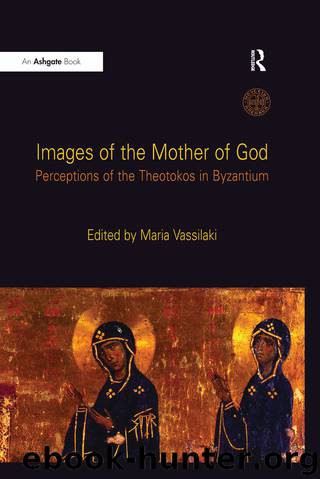Images of the Mother of God by Vassilaki Maria;

Author:Vassilaki, Maria;
Language: eng
Format: epub
Publisher: Routledge
Such an ekphrasis needs treating with care if it is to be used in the interpretation of how a Byzantine viewer would actually have responded to a work of art. Nor can we assume that our reading of the reference to the eyes conforms with sixth-century assumptions on cognition and perception.10 Nelson has discussed the difference between Byzantine optics and those of the post-mediaeval world in the West; he proposes that while the intromission theory became predominant in the late mediaeval West, in Byzantium both intromission and extramission theories were known, but Photios and other writers favoured extramission thinking. So Photios in his homily on the apse mosaics of Hagia Sophia in 867 assumed that optical rays emerged from the viewer’s eyes, contacted the object of vision and then returned to the eye and conveyed the essence of the vision to the mind and memory. In the case of our epigram, we can understand on this theory howthe viewer ‘can directly venerate the archangel’ as the features of the archangel are imprinted on the mind. The problem arises in interpreting when eyes meet eyes, as in the Aphrodisias wall painting of the archangel, and how far a frontal image sets up a more dynamic process. According to the extramission theory, the viewer is the active observer of the world. But in the wall painting, the viewer observes the process in reverse, where the archangel’s receptive eyes indicate that ‘the innermost prayer of the viewer is passed to the imaged’. This two-way situation underlies the complexities of the gazes in the Sinai Virgin and Saints icon, where it is the saints and not the Virgin Mary whose eyes meet the gaze of the viewer.
In the Sinai icon, the frontal gaze of the two saints invites the viewer to address prayers to them as intercessors, and to reverence the Virgin Mary as an object of love. Photios in his homily writes that the Virgin ‘fondly turns her eyes on her begotten son in the affection of her heart’.11 Although she does not in the Hagia Sophia mosaic actually appear to do this, the important point is that Photios communicates that the direct gaze is understood by him as an indication of love and adoration. In his analysis of this panel, Ernst Kitzinger introduced the notion of ‘artistic modes’ to explain the different stylistic means used to portray the martyr saints, the Virgin and the archangels.121 He suggested that different manners or styles were deliberately chosen to indicate different ‘orders of being’ or different ‘levels of reality’ (later on, he refers to the latter as ‘degrees of spirituality’). He argued that the ‘abstract mode’ was developed in the period between Justinian and iconoclasm as the most effective form for the portrayal of images ‘that lent themselves to devotional use’; he calls such figures as the saint in the Sinai icon ‘the first truly iconic figures in Byzantine art’.
Kitzinger’s theory of modes has been extremely influential in art-historical writing, but has recently come under increasing criticism.
Download
This site does not store any files on its server. We only index and link to content provided by other sites. Please contact the content providers to delete copyright contents if any and email us, we'll remove relevant links or contents immediately.
Signature in the Cell: DNA and the Evidence for Intelligent Design by Stephen C. Meyer(3075)
The Secret Power of Speaking God's Word by Joyce Meyer(2978)
Real Sex by Lauren F. Winner(2968)
The Holy Spirit by Billy Graham(2894)
The Gnostic Gospels by Pagels Elaine(2472)
Jesus by Paul Johnson(2311)
Devil, The by Almond Philip C(2283)
23:27 by H. L. Roberts(2198)
The Nativity by Geza Vermes(2180)
Chosen by God by R. C. Sproul(2123)
All Things New by John Eldredge(2105)
Angels of God: The Bible, the Church and the Heavenly Hosts by Mike Aquilina(1932)
The Return of the Gods by Erich von Daniken(1898)
Angels by Billy Graham(1887)
Knowing God by J.I. Packer(1806)
Jesus of Nazareth by Joseph Ratzinger(1769)
Evidence of the Afterlife by Jeffrey Long(1745)
The Gnostic Gospel of St. Thomas by Tau Malachi(1738)
How To Be Born Again by Billy Graham(1731)
